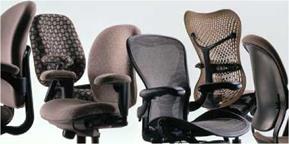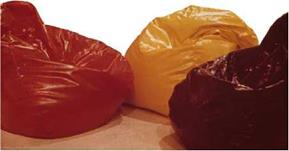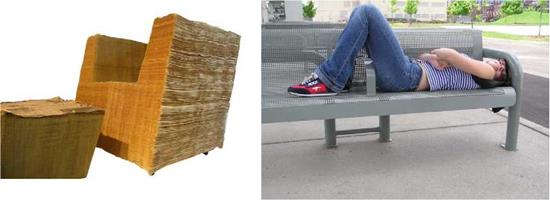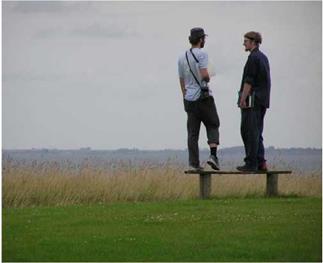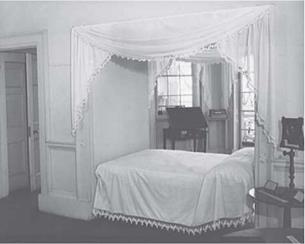Squatting is considered by many to be the first and most natural means of sitting and is especially prevalent in nomadic, African, and Eastern societies. Squatting works a variety of muscles and places the body close to the ground (Figure 2.12). Today, out of the tens of thousands of chairs available, stools and inflated therapy balls are among the few furnishings designed to accommodate a squatting posture. Squatting is physiologically healthy and doesn’t rely on the use of or need for chairs. In some places throughout the world, a cross-legged seated posture is common, while in other places, such as in Japan, kneeling is preferred. But most people in Western societies have cultural and societal preference for chairs. They desire the comfort and upright posture achieved by sitting in a chair.
Large pillows and beanbag chairs on the floor can accommodate a range of postures conforming to specific uses by adults or children. However, pillows and beanbag chairs limit body movement during use. Further, they are difficult for many to get into or out of. Most beanbag chairs are upholstered in fabric, vinyl, or leather and filled with thousands of loose, expanded polystyrene pellets that offer little support for the body. When seated, the body tends to collapse inward in a captive, static posture, which over time becomes uncomfortable (Figure 2.13).
In contrast to the static position created by the beanbag chair, many contemporary office chairs are designed for dynamic movement and multiple tasks such as typing, writing, and reading (Figure 2.14). The best are designed to accommodate a wide range of users, who perform multifunctional tasks for extended periods of time. Consumers seek comfort, appropriate support, and ergonomic resolution in today’s office environments and are willing to spend several hundred dollars for an appropriate chair. Furniture companies have invested significant resources in the research and development of ergonomic chairs, which in turn require mass production and a high volume of sales for economic feasibility.
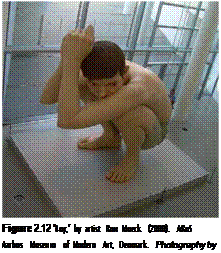 Can a chair that is designed specifically for reading a book be used to type a report? Typing requires the maintenance of correct eye position relative to the top of the computer monitor. Arms and wrists should fall at the level of
Can a chair that is designed specifically for reading a book be used to type a report? Typing requires the maintenance of correct eye position relative to the top of the computer monitor. Arms and wrists should fall at the level of
|
|
|
|
the keyboard. The spine often leans forward when typing. Reading a newspaper assumes a different posture altogether. Conventional theories suggest that an ideal seat rake (the angle between the seat pan and the seat back) for reading depends on a number of factors:
■ What one is reading
■ How long one is reading
■ Preferences concerning how one chooses to read
Most researchers and designers would agree that the seat rake for reading should be greater than 90 degrees and less than 110 degrees. Though the angle of the seat rake is important to consider in designing a chair, this measure is directly related to other aspects such as the height of the seat pan, the surrounding furnishings, the intended purposes, and the physiology of the user. Even when one considers these aspects thoughtfully, body posture will change frequently. Allowing for different postures and body movement is as important as determining appropriate dimensions and angles for an ideal body posture.
The Danish designer Niels Hvass designed and fabricated Yesterday’s Paper (1994), a chaise longue made entirely out of recycled newspaper. In one operation, an ottoman for the longue was cut out of a block of laminated newspapers, resulting in a place to sit and a support to rest one’s legs (Figure 2.15). Under the chair is a support with wheeled casters that keeps the longue off the ground. Yesterday’s Paper works well as a place to read the newspaper, but it would be a challenge to sit in a reclining position and type a report. Different functions require different postures, which often means different chairs.
A bench typically serves as a place to rest for a brief period of time. But not all benches serve the same purpose. A bench used for sitting in a cross-legged manner needs to have a deeper seat pan and a lower profile than a bench designed for people to sit in an upright manner. Benches that are subdivided or have contoured or predefined seating areas can be difficult to lie upon or incorporate personal items (Figure 2.16).
Benches seem to be everywhere. They are used at bus stops, in parks, and in lobby spaces. Benches are generally used for sitting and waiting, and perhaps for reading, talking, or writing as well, but people find uses that extend beyond conventional utility. The idea of standing on a bench in order to gain extra height to see into the distance may seem
|
Figure 2.16 The bench’s center stile makes it difficult to lie down. Photography: copyright © William A. Yokel, 2005. Permission by Alyssa Thunberg, who is in the photo. |
|
|
|
|
unusual, but the additional 17 inches (42.2 cm) provided by the bench in Figure 2.17 enabled an exceptional view of the bay that otherwise would not be possible to see.
Beds provide places to sleep. Beds also express social and cultural meaning. Consider the Japanese futon and the shikibuton, the blanket in a teepee, the canopy beds designed and fabricated during the Rococo and Victorian periods, and the waterbeds of the 1970s. Beds can be builtin, as were the once popular Murphy beds of the 1930s, or freestanding platform beds, which were popular in the 1960s. Because one conventionally enters a bed from the side, beds divide rooms patially and socially. Thomas Jefferson (1743-1826) placed his bed in an alcove located between his study and the bedroom, making it visible and accessible to both spaces while simultaneously drawing together and separating the principal bedroom from the study at his home, Monticello, located just outside Charlottesville, Virginia (Figure 2.18).

